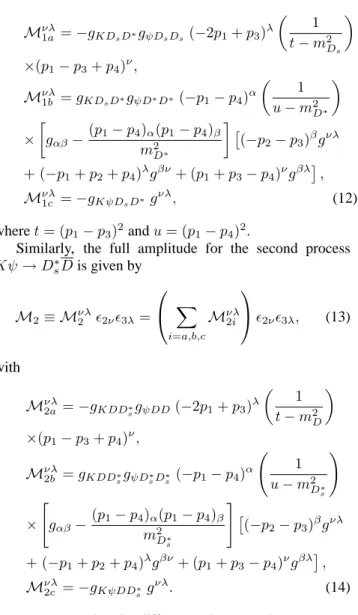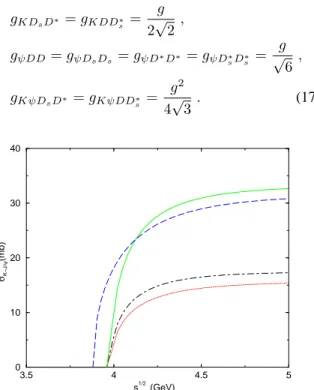272 Brazilian Journal of Physics, vol. 34, no. 1A, March, 2004
A Model for
J/ψ
- Kaon Cross Section
R.S. Azevedo and M. Nielsen
Instituto de F´ısica, Universidade de S˜ao Paulo, C.P. 66318, 05389-970 S˜ao Paulo, SP, Brazil
Received on 15 August , 2003.
We calculate the cross section for the dissociation ofJ/ψby kaons within the framework of a meson exchange model. We find that, depending on the values of the coupling constants used, the cross section can vary from 5 mb to 30 mb at√s∼5GeV.
In relativistic heavy ion collisionsJ/ψsuppression has been recognized as an important tool to identify the possible phase transition to quark-gluon plasma (QGP) [1] (for a re-view of data and interpretations see refs. [2, 3]). Since there is no direct experimental information on J/ψ absorption cross sections by hadrons, several theoretical approaches have been proposed to estimate their values. In order to elab-orate a theoretical description of the phenomenon, we have first to choose the relevant degrees of freedom. Some ap-proaches were based on charm quark-antiquark dipoles in-teracting with the gluons of a larger (hadron target) dipole [4-6] or quark exchange between two (hadronic) bags [7, 8], or QCD sum rules [9-11], whereas other works used the meson exchange mechanism [12-17]. In this case it is not easy to decide in favor of quarks or hadrons because we are dealing with charm quark bound states, which are small
and massive enough to make perturbation theory meaning-ful, but not small enough to make non-perturbative effects negligible [9-11,18].
The meson exchange approach was applied basically to J/ψ−πandJ/ψ−ρcross sections, with the only exception of ref. [13] whereJ/ψ−Kcross section was also estimated. However, as pointed out in ref. [14], there are some incon-sistencies in the Lagrangians defined in ref. [13]. In this work we will evaluate theJ/ψ−Kcross section using a meson-exchange model as in ref. [13], but we will treat the VVV and four-point couplings in the effective Lagrangians as in ref. [14].
As in refs. [13-16] we start with the SU(4) Lagrangian for the pseudo-scalar and vector mesons. The effective La-grangians relevant for the study of theJ/ψ absorption by kaons are:
⌋
LKDD∗
s =igKDD∗s D
∗µ
s
¡
D∂µK−(∂µD)K
¢
+ H.c. , (1)
LKDsD∗ =igKDsD∗ D
∗µ¡
Ds∂µK−(∂µDs)K
¢
+ H.c. , (2)
LψDD = igψDDψµ
¡
D∂µD−(∂µD)D
¢
, (3)
LψDsDs = igψDsDsψ
µ¡
Ds∂µDs−(∂µDs)Ds
¢
, (4)
LψD∗D∗ = igψD∗D∗
£
ψµ¡
(∂µD∗ν)Dν∗−D∗ν∂µD∗ν
¢
+ ((∂µψν)D∗ν−ψν∂µDν∗)D∗µ
+ D∗µ¡
ψν∂
µDν∗−(∂µψν)D∗ν
¢¤
, (5)
LψD∗
sDs∗ = igψD∗sD∗s
h
ψµ³(∂µDs∗ν)D
∗
sν−D∗sν∂µD∗sν
´
+ ((∂µψν)D∗sν−ψν∂µD∗sν)D
∗µ
s
+ D∗µ
s
³
ψν∂ µD
∗
sν−(∂µψν)D
∗
sν
´i
, (6)
LKψDsD∗ = −gKψDsD∗ψ
µ¡
D∗
µKDs+DsKDµ∗
¢
, (7)
LKψDDs∗ = −gKψDD∗s ψ
µ³D∗
sµKD+DKD∗sµ
´
, (8)
R.S. Azevedo and M. Nielsen 273
where we have defined the charm meson and kaon iso-doublets D ≡ (D0, D+), D∗
≡ (D∗0, D∗+) and K
≡
(K0, K+).
The processes we want to study for the absorption of J/ψby kaons are:
KJ/ψ→DsD∗, KJ/ψ→D∗Ds (9) KJ/ψ→D∗
sD, KJ/ψ→DD
∗
s. (10)
The two processes in eqs.(9) and (10) have the same cross section. Therefore, in Fig. 1 we only show the diagrams for the first process in eqs. (9) and (10).
D _ D _ D _
K J/ψ D
D −
s
K J/ψ D
D
s
s
K J/ψ Ds*
* * *
(2a) (2b) (2c)
(1a) (1b) (1c)
K J/ψ D D
D
s
s
K J/ψ D D
D
s
K J/ψ D
D s
* *
*
*
Figure 1. Diagrams for J/ψ absorption processes: 1) Kψ → DsD
∗
; 2) Kψ → D∗sD. Diagrams for the processesKψ → DsD∗ andKψ → D
∗
sD are similar to (1a)-(1c) and (2a)-(2c)
respectively, but with each particle replaced by its anti-particle.
Defining the four-momentum of the kaon, theJ/ψ, the vector and pseudo-scalar final-state mesons respectively by p1, p2, p3 andp4, the full amplitude for the first process Kψ →DsD∗, without isospin factors and before summing and averaging over external spins, is given by
M1≡ Mνλ1 ǫ2νǫ3λ=
X
i=a,b,c
Mνλ
1i
ǫ2νǫ3λ, (11)
with
Mνλ
1a =−gKDsD∗gψDsDs(−2p1+p3)
λ
µ
1 t−m2
Ds
¶
×(p1−p3+p4)ν,
Mνλ1b =gKDsD∗gψD∗D∗ (−p1−p4)
α
µ
1 u−m2
D∗
¶
×
·
gαβ−
(p1−p4)α(p1−p4)β m2
D∗
¸ £
(−p2−p3)βgνλ
+ (−p1+p2+p4)λgβν+ (p1+p3−p4)νgβλ
¤
,
Mνλ1c =−gKψDsD∗ g
νλ, (12)
wheret= (p1−p3)2andu= (p1−p4)2.
Similarly, the full amplitude for the second process Kψ→D∗
sDis given by
M2≡ Mνλ2 ǫ2νǫ3λ=
X
i=a,b,c
Mνλ2i
ǫ2νǫ3λ, (13)
with
Mνλ
2a =−gKDD∗
sgψDD(−2p1+p3)
λ
µ
1 t−m2
D
¶
×(p1−p3+p4)ν,
Mνλ2b =gKDD∗
sgψDs∗D∗s (−p1−p4)
α
Ã
1 u−m2
D∗ s
!
×
"
gαβ−
(p1−p4)α(p1−p4)β m2
D∗ s
# £
(−p2−p3)βgνλ
+ (−p1+p2+p4)λgβν+ (p1+p3−p4)νgβλ
¤
,
Mνλ
2c =−gKψDD∗s g
νλ. (14)
We can see that the differences between these two pro-cesses are basically due to the meson exchanged. It can be shown [14] that the full amplitudesMνλi (fori= 1,2) given above satisfy current conservation:Mνλi p2ν =Mνλi p3λ=
0.
After averaging (summing) over initial (final) spins and including isospin factors, the cross sections for these two processes are given by
dσi
dt =
1 192πsp2
0,cm
Mνλ i M∗ν
′λ′
i
µ
gνν′−
p2νp2ν′
m2 2
¶
×
µ
gλλ′−
p3λp3λ′
m2 3
¶
, (15)
withs= (p1+p2)2, and
p2 0,cm=
£
s−(m1+m2)2
¤ £
s−(m1−m2)2
¤
4s (16)
is the squared three-momentum of initial-state mesons in the center-of-momentum (c.m.) frame.
274 Brazilian Journal of Physics, vol. 34, no. 1A, March, 2004
SU(4) symmetry would give the following relations among the coupling constants:
gKDsD∗ =gKDD∗s =
g 2√2 ,
gψDD=gψDsDs=gψD∗D∗ =gψD∗sDs∗ =
g
√
6 ,
gKψDsD∗ =gKψDDs∗ =
g2
4√3 . (17)
3.5 4 4.5 5
s1/2 (GeV) 0
10 20 30 40
σK−J/
ψ
(mb)
Figure 2. Total cross sections of the processes J/ψ kaons →
D∗
Ds+D∗Ds(dot-dashed line),D Ds∗+D ∗
sD(dotted line).
The solid line gives the total J/ψ dissociation by kaons cross section. For comparison, the dashed line gives the J/ψ π → D D∗+D D∗cross section.
ForψDD, ψDsDs, ψD∗D∗andψDs∗D∗scouplings we follow refs. [12, 14] and make use of the vector meson dom-inance model (VDM). We get
gψDD=gψDsDs=gψD∗D∗ =gψD∗sDs∗ = 7.64. (18)
Using the above SU(4) relations we get for the other cou-pling constants:
gKDsD∗ =gKDD∗s = 6.6, (19)
andgKψDsD∗ =gKψDD∗s = 50.55.
The solid line in Fig. 2 shows the total cross section of J/ψdissociation by kaons as a function of the initial energy
√s. The dot-dashed line includes the contribution for both
KJ/ψ → DsD∗ andKJ/ψ → D∗Ds, while the dotted line includes the contribution for bothKJ/ψ→D∗
sDand KJ/ψ→DD∗s. In Fig. 2 we also show, for comparison, the cross section for the processπJ/ψ→D∗D+D∗D(dashed
line) using the same coupling constants as in ref. [14]. We see that, considering all allowed process for the J/ψ dis-sociation by kaons, we get a cross section bigger than the pion-J/ψdissociation cross section.
If instead of using the VDM to determine the couplings, we follow ref. [13] and use the experimental value of the ρππcoupling constant:
gρππ= g
2 = 6.06, (20)
we get:
gψDD=gψDsDs=gψD∗D∗ = gψD∗sD∗s = 4.95
gKDsD∗ =gKDD∗s = 4.3. (21)
In this case we get a much smaller cross section, as can be seen by the solid line in Fig. 3, where we also show (dot-dashed line) the previous result.
3.5 4 4.5 5
s1/2 (GeV) 0
10 20 30 40
σK−J/
ψ
(mb)
Figure 3. Total cross sections ofJ/ψdissociation by kaons eval-uated by using the values for the couplings given by Eqs. (18) and (19) (dot-dashed line) and by Eq. (21) (solid line).
As can be seen by Fig. 3, the result for the cross section can vary by almost one order of magnitude, even without considering form factors in the hadronic vertices [14, 16]. This gives an idea of how important it is to have a good esti-mate of the value of the coupling constants. In a recent work [19], theJ/ψ−πandJ/ψ−ρcross sections were evalu-ated by using form factors and coupling constants estimevalu-ated using QCD sum rules [20, 21, 22, 23]. The results show that with the appropriate form factors, the total cross section can even fall for values of√sbigger than 4.5 GeV. In a future work we will include from factors in the hadronic vertices as well as anomalous parity interactions [16].
In summary, we have studied the cross section of J/ψ dissociation by kaons in a meson-exchange model that includes pseudo-scalar-pseudo-scalar-vector-meson couplings, three-vector-pseudo-scalar-pseudo-scalar-vector-meson couplings, and four-point couplings. We find that these cross sections are even bigger than theJ/ψ−π→DD∗+D∗Ddissociation cross
section, and have a very strong dependence with the values of the coupling constants in the hadronic vertices. Resulting cross sections can vary between 5 mb and 30 mb for√s∼5
GeV, depending on the values of the couplings. Since these couplings are not known experimentally, it is very important to have better estimates for them.
Acknowledgments
This work was supported by CNPq and FAPESP.
References
R.S. Azevedo and M. Nielsen 275
[3] C. Gerschel and J. Huefner, Ann. Rev. Nucl. Pat. Sci., 49, 255 (1999).
[4] G. Bhanot and M.E. Peskin, Nucl. Phys. B156, 391 (1979); M.E. Peskin, Nucl. Phys. B156, 365 (1979).
[5] D. Kharzeev and H. Satz, Phys. Lett. B334, 155 (1994). [6] S.H. Lee and Y. Oh, J. Phys. G28, 1903 (2002); Y. Oh, S. Kim,
and S.H. Lee, Phys. Rev. C65, 067901 (2002).
[7] C.-Y. Wong, E.S. Swanson, and T. Barnes, Phys. Rev. C62, 045201 (2000); C65, 014903 (2001).
[8] K. Martins, D. Blaschke, and E. Quack, Phys. Rev. C51, 2723 (1995).
[9] F.S. Navarra, M. Nielsen, R.S. Marques de Carvalho, and G. Krein, Phys. Lett. B529, 87 (2002).
[10] F.O. Dur˜aes, S.H. Lee, F.S. Navarra, and M. Nielsen, Phys. Lett. B564, 97 (2003).
[11] F.O. Dur˜aes, H. Kim, S.H. Lee, F.S. Navarra, and M. Nielsen, nucl-th/0211092.
[12] S.G. Matinyan and B. M¨uller, Phys. Rev. C58, 2994 (1998). [13] K.L. Haglin, Phys. Rev. C61, 031902 (2000).
[14] Z. Lin and C.M. Ko, Phys. Rev. C62, 034903 (2000). [15] K.L. Haglin and C. Gale, Phys. Rev. C63, 065201 (2001). [16] Y. Oh, T. Song, and S.H. Lee, Phys. Rev. C63, 034901
(2001); Y. Oh, T. Song, S.H. Lee and C.-Y. Wong, ncl-th/0205065.
[17] F.S. Navarra, M. Nielsen, and M.R. Robilotta, Phys. Rev. C64, 021901 (R) (2001).
[18] H.G. Dosch, F.S. Navarra, M. Nielsen, and M. Rueter, Phys. Lett. B466, 363 (1999).
[19] K.L. Haglin and C. Gale, hep-ph/0305174.
[20] F.S. Navarra, M. Nielsen, M.E. Bracco, M. Chiapparini, and C.L. Schat, Phys. Lett. B489, 319 (2000).
[21] F.S. Navarra, M. Nielsen, and M.E. Bracco, Phys. Rev. D65, 037502 (2002).
[22] R.D. Matheus, F.S. Navarra, M. Nielsen, and R. Rodrigues da Silva, Phys. Lett. B541, 265 (2002).

